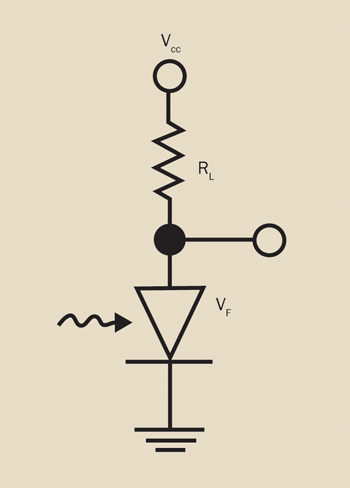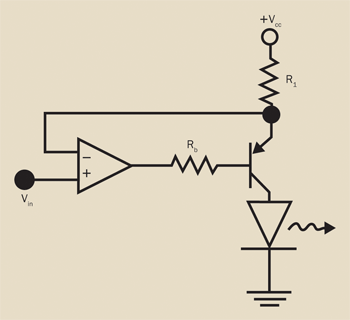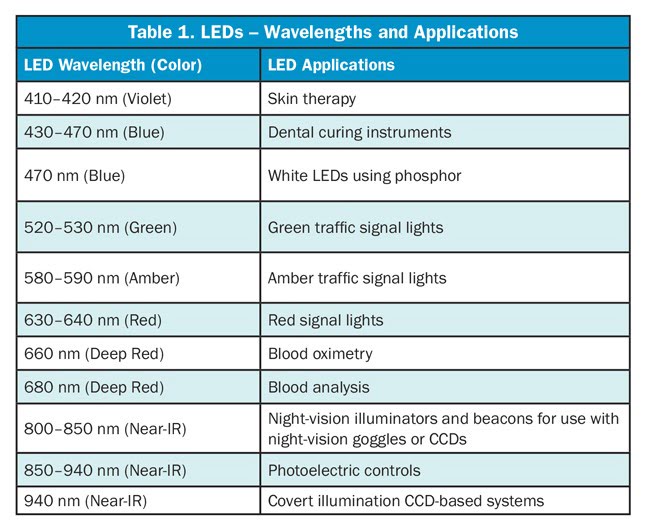Light-emitting diodes (LEDs) are semiconductors that convert electrical energy into light energy. The color of the emitted light depends on the semiconductor material and composition, with LEDs generally classified into three wavelengths: ultraviolet, visible, and infrared.
Opto Diode Corporation, An ITW company
The wavelength range of commercially available LEDs with single-element output power of at least 5 mW is 275 to 950 nm. Each wavelength range is made from a specific semiconductor material family, regardless of the manufacturer. This article will provide an overview of the LED operation and a brief look at the industry. Various types of LEDs, the corresponding wavelengths, materials used in their composition, and some applications for the specific lamps will also be discussed.
Ultraviolet LEDs (UV LEDs): 240 to 360 nm
UV LEDs are specifically used for industrial curing applications, water disinfection, and medical/biomedical uses. Power output levels greater than 100 mW have been achieved at wavelengths as short as 280 nm. The material primarily used for UV LEDs is gallium nitride/aluminum gallium nitride (GaN/AlGaN) at wavelengths 360 nm or longer. Shorter wavelengths utilize proprietary materials. While the market for wavelengths 360 nm and longer is stabilizing because of lower prices and plentiful suppliers, shorter wavelengths are manufactured by only a few suppliers, and the prices for these LEDs are still very high compared with the rest of the LED product offerings.
Near-UV to green LEDs: 395 to 530 nm
The material for this wavelength range of products is indium gallium nitride (InGaN). While it is technically possible to make a wavelength anywhere between 395 and 530 nm, most large suppliers concentrate on creating blue LEDs (450 to 475 nm) for producing white light with phosphors, and green LEDs in the 520- to 530-nm range for traffic signal green lighting. The technology for these LEDs is generally viewed as mature. Improvements in optical efficiency have slowed down or stopped over the last few years.
Yellow-green to red LEDs: 565 to 645 nm
Aluminum indium gallium phosphide (AlInGaP) is the semiconductor material used for this wavelength range. It is predominately made in traffic signal yellow (590 nm) and traffic signal red (625 nm). The lime-green (or yellowish-green 565 nm) and orange (605 nm) are also available in this technology but have limited availability.
It is interesting to note that neither the InGaN nor AlInGaP technologies are available as a pure green (555 nm) emitter. Older, less efficient technologies do exist in this pure green region but are not considered efficient or bright. This is due largely to a lack of interest/demand from the marketplace and therefore a lack of funding to develop alternative material technologies for this wavelength region.
Deep red to near-infrared (IRLEDs): 660 to 900 nm
There are many variations on device structure in this region, but all use a form of aluminum gallium arsenide (AlGaAs) or gallium arsenide (GaAs) materials. Applications include infrared remote controls, night-vision illumination, industrial photocontrols and various medical applications (at 660–680 nm).
Theory of LED operation
LEDs are semiconductor diodes that emit light when an electrical current is applied in the forward direction of the device — an electrical voltage that is large enough for the electrons to move across the depletion region and combine with a hole on the other side to create an electron-hole pair must be applied. As this occurs, the electron releases its energy in the form of light, and the result is an emitted photon.
The bandgap of the semiconductor determines the wavelength of emitted light. Shorter wavelengths equal greater energy, and therefore higher-bandgap materials emit shorter wavelengths. Higher-bandgap materials also require higher voltages for conduction. Short-wavelength UV-blue LEDs have a forward voltage of 3.5 V, while near-IR LEDs have a forward voltage of 1.5 to 2.0 V.
Wavelength availability and efficiency considerations
The overriding factor as to whether or not a specific wavelength is commercially available has to do with market potential, demand and industry-standard wavelengths. This is particularly pronounced in the 420- to 460-nm, 480- to 520-nm and the 680- to 800-nm regions. Because there are no high-volume applications for these wavelength ranges, there are no high-volume manufacturers providing LED products for these ranges. However, it is possible to find small- or medium-size suppliers offering products to fill these particular wavelengths on a custom basis.

Figure 1. The current value is found by applying the equation I = (Vcc − VF)/RL. To be absolutely certain of the current flow in the circuit, each LED VF would have to be measured and the appropriate load resistor specified. In practical commercial applications, Vcc is designed to be much larger than VF and thus the small changes in VF, do not affect the overall current by a large amount. The negative aspect of this circuit is a large power loss through RL.
Each material technology has a spot within the wavelength range where it is most efficient, and this point is very close to the middle of each range. As the doping level of the semiconductor increases or decreases from the optimal amount, efficiency suffers. That is why a blue LED has much greater output than green or near-UV, amber has more than yellow-green, and near-IR is better than 660 nm. When given a choice, it is much better to design for the center of the range than at the edges. It is also easier to procure products that do not fall close to the edges of the material technology.
Supplying current and voltage to LEDs
While LEDs are semiconductors and need a minimum voltage to operate, they are still diodes and must be operated in a current mode. There are two main ways to operate LEDs in DC mode: The easiest and most common is using a current-limiting resistor. The disadvantage to this method is the high heat and power dissipation in the resistor. For the current to be stable over temperature changes and from device to device, the supply voltage should be much greater than the forward voltage of the LED.
In applications where the operating temperature range is narrow (less than 30 °C) or the output of the LED is not critical, a simple circuit utilizing a current-limiting resistor may be used, as shown in Figure 1.

Figure 2. An example of an accurate and stable circuit. This circuit is commonly referred to as a constant current source. Note that the supply current is determined by the supply voltage (Vcc) minus Vin divided by R1, or (Vcc − Vin)/R1.
A better way to drive the LED is with a constant current source (Figure 2). This circuit will provide the same current from device to device and over temperature changes. It also has lower power dissipation than using a simple current-limiting resistor.
Commercial off-the-shelf LED drivers are available from a number of different sources. Typically these operate using pulse width modulation principles for brightness control.
Pulsing LEDs in high-current and/or high-voltage mode for arrays in a series-parallel configuration creates a unique set of problems. For the novice designer, it is not practical to design a current-controlled pulse drive with the capability to deliver 5 A and 20 V. There are a few manufacturers of specialty equipment for pulsing LEDs.
LEDs in human viewed applications
In applications where LEDs are being viewed directly or being used as illuminators, exact color is far more important than exact output in lumens or candela. The human eye is relatively insensitive to light intensity changes, and the brain compensates quite well for what intensity changes occur. For example, looking at an LED video screen on a building, the average person will not notice an intensity drop of 20% as portions of the screen are viewed at 10° to 20° off-axis, as compared to the portion directly on-axis, as this is a gradual change moving toward the edge of vision and is not perceived. In contrast, if LEDs in one location are 10 nm different in wavelength than in other sections, the human eye will easily see this color difference and find it distracting.
The majority of white LEDs being used today are made from a blue LED pumping a longer wavelength visible phosphor. Color rendering index (CRI) is a measure of the spectral matching to sunlight. 100 is considered to be the same as sunlight and most LEDs used in general illumination today have a CRI greater than 80. The CRI improvements along with better optical efficiency have positioned white LEDs as the most desirable product for most illumination applications.
LED advantages and applications
LEDs for monochromatic applications have huge advantages over filtered lamps — the wavelength spectra are better defined than what can be achieved with a white light source and filter. For general lighting applications, the energy savings can easily be 100 times the operating cost of using a filtered incandescent lamp. This creates huge dividends in applications such as architectural lighting and traffic signals. Low-power portable highway LED signage can easily be powered by a small solar panel instead of a large generator, offering a distinct advantage.

LEDs are more reliable than lasers, generally cost less and can be driven with lower-cost circuitry. The European Union has now joined with the U.S. in classifying LEDs as a separate entity. Fortunately, LEDs do not carry the same eye safety concerns or warnings that lasers and laser diodes do. On the other hand, LEDs cannot be made into extremely small, highly collimated and optically dense spots. In applications where extremely high power density within a small area is required, a laser is almost always required.
LEDs are now used in a large number of diverse markets and applications (Table 1). Their high reliability, high efficiency, and lower overall system cost compared with lasers and lamps make these devices very affordable and attractive to both consumer and industrial segments. Each individual LED technology and/or color has been developed to address specific uses and requirements.